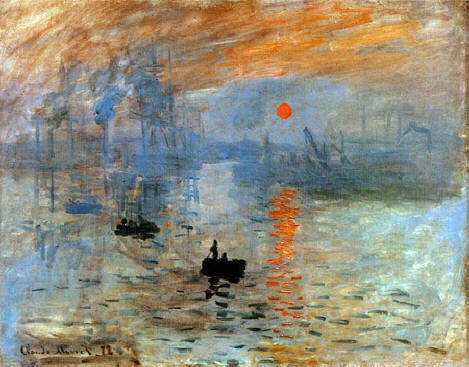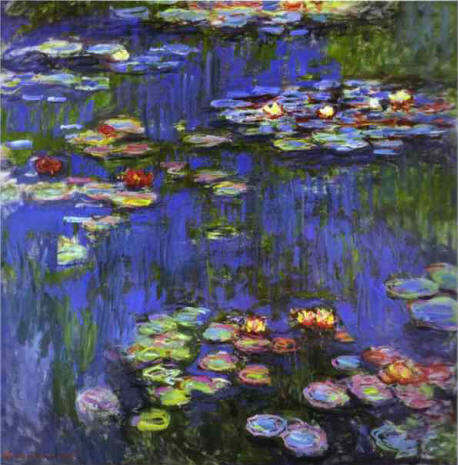-


 Claude Monet
Claude Monet
French
Impressionist
Claude Monet is generally considered to be the most outstanding figure among Impressionists. The term Impressionism derives from his picture "Impression: Sunrise". A title was needed in a hurry for the catalogue of the exhibition in 1874. Claude Monet suggested simply Impression, and the catalogue editor, Renoir's brother Edouard, added an explanatory Sunrise. The artist was not to know that because of criticism which seized upon the first word he had given the entire movement its name. Monet's concern was to reflect the influence of light on a subject. Claude Monet never abandoned his Impressionist painting style until his death in 1926 when Fauvism and Cubism were en vogue and when abstract painting came into existence. Claude Monet was born on November 14, 1840 on the fifth floor of 45 rue Laffitte, in the ninth arrondissement of Paris.
Claude Monet was the second son of Claude-Adolphe and Louise-Justine Aubrée Monet, both of them second-generation Parisians. In 1845, his family moved to Le Havre in Normandy. His father wanted him to go into the family grocery business, but Monet wanted to become an artist. On the first of April 1851, Claude Monet entered the Le Havre secondary school of the arts. Claude Monet first became known locally for his charcoal caricatures, which he would sell for ten to twenty francs. Close to his home was a little shop owned by a marine painter, Mr. Eugene Boudin. He recognized the talent of the boy and gave him his first painting lessons. On January 28, 1857 Claude Monet's mother died. He was 16 years old when he left school and went to live with his widowed childless aunt, Marie-Jeanne Lecadre.
Claude Monet turned away from the traditional style of painting inside a studio. With his new friends he went outside in the Fontainebleau forest to paint in the open air. But the public and art critics ridiculed these new paintings that looked so different from any conventional art style. In a caricature published in a newspaper, they were mocked with the proposal of chasing away the Prussian enemy by showing them Impressionist paintings. When the Franco-Prussian war of 1870-1871 broke out, Monet chose to go to London with his friend Pissarro. There Claude Monet saw the paintings of William Turner in the museums of London. After 1880 the public slowly begun to recognize the value of impressionism. Claude Monet and his friends could finally get some solid income from the sales of their paintings. In 1883 Monet rented a house in Giverny about 50 kilometers outside of Paris. Later, in 1890, Claude Monet bought the house where he would stay until his death in 1926.
Claude Monet and his friend, artist Frédéric Bazille occupied a joint studio in Paris in 1865. Monet showed two maritime paintings in the Salon and encouraged by the positive reviews, he ambitiously started a large-format figurative painting, "The Picnic". Here, Claude Monet is first reported to have met Camille Doncieux who works as a model for the painting, together with Bazille. "The Picnic" was not completed in time for the Salon, so Monet painted the life-sized portrait Camille. The critics praise the painting; for many, it calls to mind the works of Edouard Manet.
Due to his great success in the Salon, Monet’s relatives continue to back him for a while, and he is able to paint without financial worries in the summer of 1866. Soon though, Claude Monet is once again in financial straits. Monet's family refuses to support him any longer, and the painting "Women in the Garden "is rejected by the jury of the Salon. In spring, it turns out that Camille is expecting a child. The numerous pleas for help Monet sends to Bazille give evidence of how hopeless his situation is. Camille gives birth to their first child, Jean in 1867. In 1868, due to financial reasons, Claude Monet attempted suicide by throwing himself into the Seine. Despite the boldness of his color and the extreme simplicity of his compositions,
Monet was recognized as a master of meticulous observation and an artist who sacrificed neither the true complexities of nature nor the intensity of his own feelings. In the 1880s and 1890s, Monet began "series" painting, repetitive paintings of one subject in varying light and viewpoints. The first subject were the haystacks behind his house. As the light changed during the day faster than Claude Monet could paint, he worked simultaneously on several canvases. At the end Claude Monet had painted 25 different versions of the hay stacks.